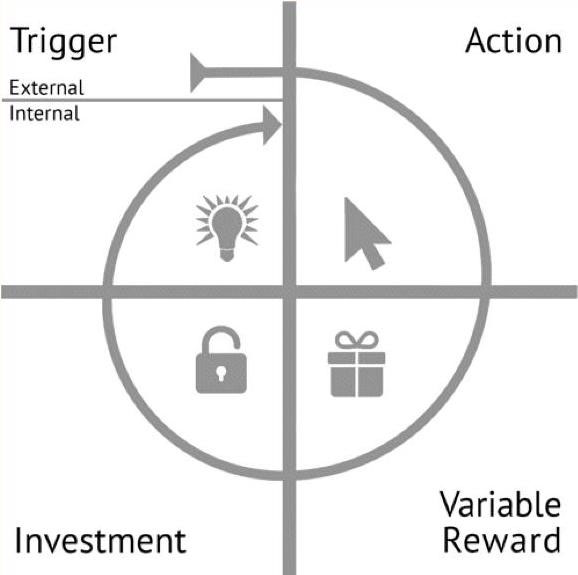What is the Hooked Method?
The “Hooked” method came about from a book written by Nir Eyal in 2014 called “Hooked: How to Build Habit-Forming Products”. He spent years researching how Products and more specifically technology create patterns and change peoples’ day to day habits. Approximately 50% of what we do in our daily lives is based on the habits that we develop. Habits are activities that we take part in days where we have little or no conscious thought. In this research, he found that there’s a specific pattern in the psychology of forming habits. Eyal refers to this pattern as “The Hook”.
“The Hook” is when you create a product or service that is designed to take your user’s problem and connect them to your solution with enough frequency to form a habit. A trigger has four parts, a trigger, an action, a reward, and an investment.

Trigger
Triggers are things that initiate action from the users. Eyal has broken triggers down into two variables; an internal trigger and an external trigger. An external trigger is something that happens outside of the user that triggers them to desire using your product. Example: A commercial or ad would all be examples of external triggers. Internal triggers are internal desires to use your product. Example: Boredom, loneliness, a desire to zone out would all be examples of internal triggers.
To develop a trigger for your product, you need to understand your users and what their triggers may be. You need to find out what their desire is so that you can fulfill that desire with your product.
Action
In this step of your Product Development, you’ll want to create a simple action that creates the anticipation of a reward for your user. By action, this refers to developing a feature within your product that requires users to interact in a way that is “action” related so that they are interacting as opposed to simply observing. Example: Typing a question into a browser. The user is interacting with the browser and the reward is receiving the answers they were looking for.
BJ Fog, a researcher at Stanford University created a formula to determine how likely a user is to take action with a product or a service. He says “Behavior happens when motivation, ability, and a prompt come together at the same moment”. Motivation is the energy or desire to take action. Ability is the capacity to interact or use the product you’ve developed. In other words, your product needs to be accessible and easy to use. Lastly, there must be a trigger (prompt) in place to create a behavior.
Reward
Your users have made it through the first two steps and now it’s time for your user to receive their reward. The important part to understand about the reward systems is that the reward needs to vary each time it’s given in order to create motivation for your user to return for the reward often. Psychologist, B.F. Skinner discovered in his research titled Operant Conditioning that the most successful return rate is “Variable Interval Reinforcement”. Meaning that rewards are given at unpredictable times and in unpredictable quantities. This is the same system that is used in gambling. Example: You post a photo on Facebook, with anticipation of likes and comments. The “Variable Interval Reinforcement” aspect is that the number of likes are unpredictable and are different with each post.
Investment
Now that your user has received their reward, it’s time to encourage your users’ investment into your product to ensure that they will return for another pass through “The Hook”. Investments come in two forms, loading the next trigger and stored value. You can load the next trigger by sending an email with a link that directs them back to your product. Another example is when Facebook sends you notifications on your phone that people have liked your content. Stored value in a product refers to how much investment a user has committed into your product, that they would lose if they did not return. Example: The YouTube subscriber count is a way to keep the content creator on YouTube coming back for more. If they have invested 5 years of their time to get 100k YouTube subscribers, they are unlikely to move to another platform if a competitor pops up, and they are likely to return to your platform to continue to increase or maintain their count. The time spent is their investment, and the subscriber count is their value.
The goal of “The Hook” is to get your users to pass through all four phases on an infinite loop, essentially never leaving your product. It’s the method that is being used in the majority of social media, as well as gambling. Not only is the Psychology of Habit Design effective it is manipulative. If you choose to apply this method to your product, do so with caution and with care.